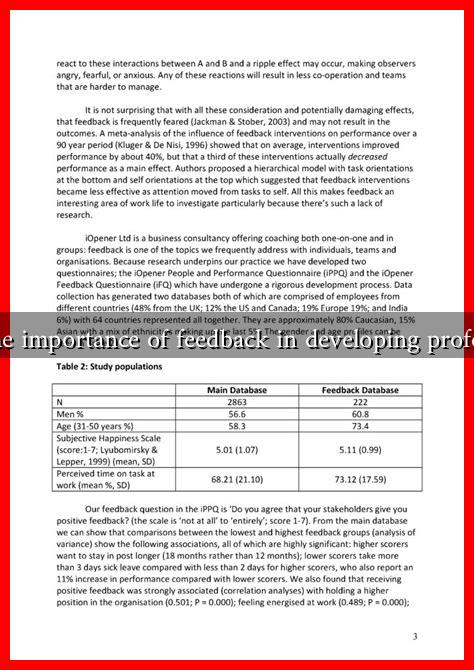-
Table of Contents
What’s the Importance of Feedback in Developing Professionally
In today’s fast-paced and ever-evolving work environment, professional development is crucial for career advancement and personal growth. One of the most effective tools for fostering this development is feedback. Feedback, when delivered constructively, can serve as a catalyst for improvement, innovation, and success. This article explores the importance of feedback in professional development, highlighting its benefits, methods of delivery, and real-world examples.
The Role of Feedback in Professional Growth
Feedback is essential for several reasons:
- Identifies Strengths and Weaknesses: Constructive feedback helps individuals recognize their strengths and areas for improvement. This self-awareness is vital for personal and professional growth.
- Enhances Performance: Regular feedback can lead to improved performance by providing specific guidance on how to enhance skills and competencies.
- Encourages Continuous Learning: Feedback fosters a culture of continuous learning, motivating individuals to seek out new knowledge and skills.
- Builds Confidence: Positive feedback can boost an individual’s confidence, encouraging them to take on new challenges and responsibilities.
Types of Feedback
Feedback can be categorized into several types, each serving a unique purpose:
- Formal Feedback: This type is often structured and occurs during performance reviews or evaluations. It typically includes specific metrics and goals.
- Informal Feedback: This is spontaneous and can happen in day-to-day interactions. It is often more immediate and can address issues as they arise.
- Peer Feedback: Colleagues can provide valuable insights based on their observations, fostering a collaborative environment.
- Self-Feedback: Individuals can reflect on their own performance, identifying areas for improvement and setting personal goals.
Effective Feedback Delivery
Delivering feedback effectively is crucial for it to be well-received and acted upon. Here are some best practices:
- Be Specific: Vague feedback can lead to confusion. Providing specific examples helps the recipient understand exactly what they need to improve.
- Focus on Behavior, Not Personality: Feedback should address actions and outcomes rather than personal attributes to avoid defensiveness.
- Encourage Dialogue: Feedback should be a two-way conversation. Encourage the recipient to share their thoughts and feelings about the feedback.
- Follow Up: After providing feedback, check in with the individual to see how they are progressing and offer additional support if needed.
Real-World Examples and Case Studies
Numerous organizations have recognized the importance of feedback in professional development. For instance, Google has implemented a culture of continuous feedback through its “Project Oxygen,” which emphasizes the role of managers in providing regular feedback to their teams. According to a study by Google, teams with effective feedback mechanisms showed a 25% increase in performance.
Another example is Adobe, which replaced annual performance reviews with a system called “Check-In,” allowing for ongoing feedback. This shift resulted in a 30% increase in employee engagement and satisfaction, demonstrating the positive impact of timely and constructive feedback.
Statistics on Feedback and Professional Development
Research supports the significance of feedback in professional development:
- A study by Gallup found that employees who receive regular feedback are 3.6 times more likely to be engaged in their work.
- According to a report by Zenger/Folkman, 92% of employees believe that negative feedback, if delivered appropriately, is effective for performance improvement.
- Research from the Harvard Business Review indicates that organizations with a strong feedback culture have 14.9% lower turnover rates.
Conclusion
Feedback is a powerful tool for professional development, offering insights that can lead to significant improvements in performance, confidence, and overall job satisfaction. By understanding the different types of feedback, employing effective delivery methods, and learning from real-world examples, individuals and organizations can create a culture that values continuous improvement. As the workplace continues to evolve, embracing feedback will be essential for anyone looking to advance their career and achieve their professional goals.
For further reading on the importance of feedback in the workplace, you can explore resources from Forbes.

